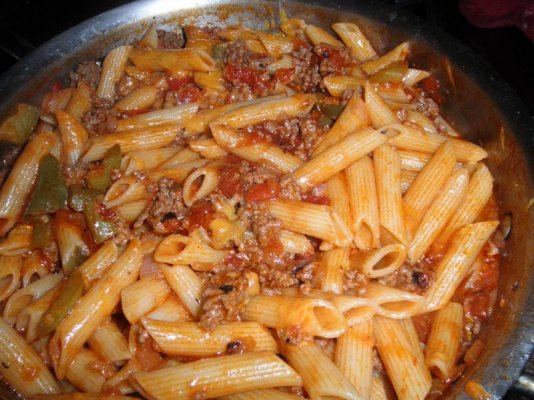Chief Longwind Of The North
Certified/Certifiable
I have been making my pasta the way I was taught for 40-some years, i.e. boil in salted water to al dente. It has worked well. But the past few times, I changed my method, incorporating tips from D.C. and the no-boil lasagna idea.
From DC, I learned that adding a bit of the pasta water to the sauce helps the sauce adhere to the pasta better. I also know that Italian pasta is more about tha pasta, with the sauce used to enhance the noodles, and is often baked. So I tried to combine this knowledge to make the perfect pasta.
I love a gret ragu,, or bolognese. If my kidneys allowed it, I could eat the sauce all by itself, like a soup. The pasta noodle adds texture and flavor though, and I love that as well. With my love of sauce, I want it rich with herbs andd all the flavrs that a great sauce must have. I want it thick and not watery. Lastly, I want it to adhere strongly to whatever pasta type I'm using. I now have changed my tecnique to achive my perfect pasta.
First, I prefer a hearty pasta, suck as linguini, penne, rotiny, or cabatapi, with the last being my favorite. In reality, this technique can be used with any wheat-flor based pasta shape.
Now for the sauce; I make a thick ragu with browned ground beef, rustic chopprd onion , sweet fully ripe bell peppers, all seasone with basil, oregano, rosemary, thime, and fresh garlic. I use tomato puree as the tomato base, no sugar, no tomato paste is required. The acidity of the puree is ballaned by the whole onion's sweetness.
When the sauce is just right, I add 2 cups of water and stir it. I then add 1 cup of dried pasta of choice. I bring it to a gentle boil, cover the pot, and let all cook for 15 minutes, stirring every 5 minutes or so
The noodle release starch into the watery sauce helping both to thicken the sauce, and make it adhere to the noodle. The noodle absorbs flavor from the sauce, as well as soaking up just the right amount of water.
When the noodles are perfectly al denty, the sauce has again thickend, and adheres perfectly to the pasta. With hollow nootles such as cavatapi, macoroni, rigatoni, etc. the sause coats the noodle inside and out.
If you love a great sauce, and want it to really be a major player in your pasta dish, give this method a try.
One more tip, when using a thick noodle with this technique, over-season a bit so that the noodle flavor ballances properly with the sauce flavor.
I have used this technique on th stovetop with no oven reqired, several times now. For me, it has made superior pasta compared to any other metod. Bes of all, it has been no fail. I don' get watery sauce, where the water seperates from the tomato meat.
I hope this has been clear and informative.
Seeeeya; Chief Longwind of the North
From DC, I learned that adding a bit of the pasta water to the sauce helps the sauce adhere to the pasta better. I also know that Italian pasta is more about tha pasta, with the sauce used to enhance the noodles, and is often baked. So I tried to combine this knowledge to make the perfect pasta.
I love a gret ragu,, or bolognese. If my kidneys allowed it, I could eat the sauce all by itself, like a soup. The pasta noodle adds texture and flavor though, and I love that as well. With my love of sauce, I want it rich with herbs andd all the flavrs that a great sauce must have. I want it thick and not watery. Lastly, I want it to adhere strongly to whatever pasta type I'm using. I now have changed my tecnique to achive my perfect pasta.
First, I prefer a hearty pasta, suck as linguini, penne, rotiny, or cabatapi, with the last being my favorite. In reality, this technique can be used with any wheat-flor based pasta shape.
Now for the sauce; I make a thick ragu with browned ground beef, rustic chopprd onion , sweet fully ripe bell peppers, all seasone with basil, oregano, rosemary, thime, and fresh garlic. I use tomato puree as the tomato base, no sugar, no tomato paste is required. The acidity of the puree is ballaned by the whole onion's sweetness.
When the sauce is just right, I add 2 cups of water and stir it. I then add 1 cup of dried pasta of choice. I bring it to a gentle boil, cover the pot, and let all cook for 15 minutes, stirring every 5 minutes or so
The noodle release starch into the watery sauce helping both to thicken the sauce, and make it adhere to the noodle. The noodle absorbs flavor from the sauce, as well as soaking up just the right amount of water.
When the noodles are perfectly al denty, the sauce has again thickend, and adheres perfectly to the pasta. With hollow nootles such as cavatapi, macoroni, rigatoni, etc. the sause coats the noodle inside and out.
If you love a great sauce, and want it to really be a major player in your pasta dish, give this method a try.
One more tip, when using a thick noodle with this technique, over-season a bit so that the noodle flavor ballances properly with the sauce flavor.
I have used this technique on th stovetop with no oven reqired, several times now. For me, it has made superior pasta compared to any other metod. Bes of all, it has been no fail. I don' get watery sauce, where the water seperates from the tomato meat.
I hope this has been clear and informative.
Seeeeya; Chief Longwind of the North


